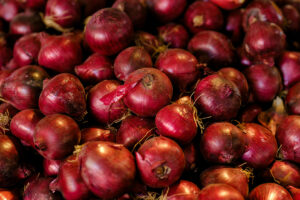Agri dep’t questioned over onion imports ahead of harvest season

A PHILIPPINE Senator on Monday questioned the Department of Agriculture (DA) plans to allow the importation of red and yellow onions as the harvest season is expected to begin.
“Before bringing in imports, make sure you’re not burying our farmers’ livelihood in the process,” Senator Maria Imelda R. Marcos said in a statement in Filipino.
Last week, the DA said that it would allow the importation of 4,000 metric tons (MT) of onions to ensure stable prices as local stocks are running low.
The Agriculture department has permitted the shipment of 3,000 MT of red onions and 1,000 MT of white onion, expected to arrive by Feb. 20.
Ms. Marcos questioned the need for further onion imports, adding that the local harvest season had already begun.
She added the onion prices are expected to drop during harvest time amid the influx of local supply.
“Why bring in imports now when we know this would mean losses for our farmers?” she asked.
Agriculture Secretary Francisco P. Tiu Laurel, Jr. had said that the agency allowed the importation of onions to avoid risks of a potential shortage and further spikes in prices.
Ms. Marcos said that the DA should also take action on individuals stockpiling onions in cold storage facilities.
“Even if we have enough supply, prices will still skyrocket if hoarders are in control,” she added.
The inventory for red onions was tallied at 2,325.86 MT with white onion stocks at 631.44 MT, according to Bureau of Plant Industry, as of Jan. 31.
Last year, the DA allowed white onion imports totaling 17,000 MT, after delaying imports until August due to higher production.
Meanwhile, Senator Sherwin T. Gatchalian asked the Trade department to enhance monitoring of bread prices in response to the rising retail costs.
“The Department of Trade and Industry (DTI) should strictly monitor prices of bread to prevent unscrupulous traders and retailers from unduly hiking prices given that bread is an alternative to rice, which has remained costly,” Mr. Gatchalian said in a statement.
He added that any increase in bread prices should be “both reasonable and justified,” citing the need for transparency in pricing.
Last week, the DTI had issued a new suggested retail price (SRP) for basic necessities and prime commodities, which included the SRP for bread.
The SRP for a 450-gram pack of Pinoy tasty went up to P44 from P40.5, while Pinoy tasty saw prices rise to P27.5 from P25 for a 250-gram pack, according to the Trade department’s SRP bulletin as of Feb. 1. These brands are the only stock-keeping units under the bread category.
“The government should explore measures to stabilize production costs, such as securing reliable chains for wheat and other essential ingredients and providing necessary support for bakers to enhance production efficiency,” Mr. Gatchalian added.
The country typically imports most of its wheat requirement for the processing of flour for bread and other baked goods, while animal grade wheat is imported for feed.
According to the United States Department of Agriculture, the Philippines may import 7 million MT of wheat in 2025. — Adrian H. Halili




